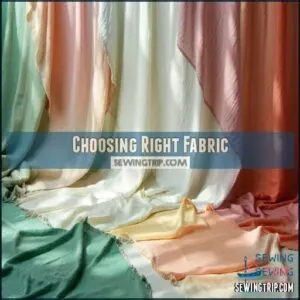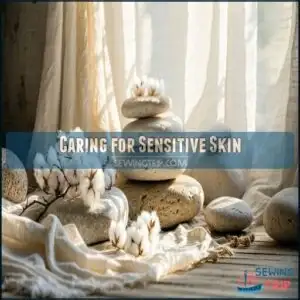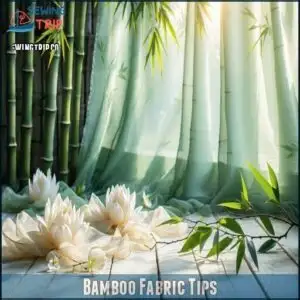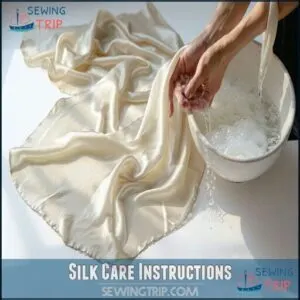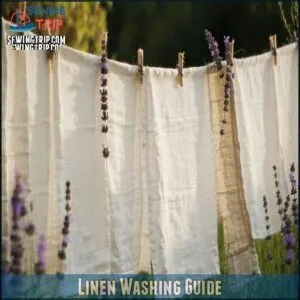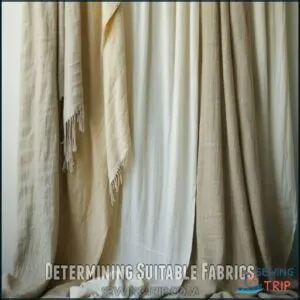This site is supported by our readers. We may earn a commission, at no cost to you, if you purchase through links.

Cotton is soft, breathable, and hypoallergenic—perfect for everyday comfort. Bamboo adds moisture-wicking magic, while silk offers a smooth, luxurious touch that won’t irritate.
Linen? It’s your summer savior, keeping you cool without the itch. Watch out for synthetic fabrics like polyester, which can trap heat and irritate, or wool, which may feel scratchy.
The right fabric’s like a gentle hug—supportive and comfortable. And don’t forget, how you wash these matters just as much as what you wear, making it a crucial part of choosing the best fabric for sensitive skin, with a smooth and irritation-free experience.
Table Of Contents
- Key Takeaways
- Choosing Right Fabric
- Fabric Properties Explained
- Best Fabrics for Skin
- Fabrics to Avoid Always
- Caring for Sensitive Skin
- Sensitive Skin Fabric Care
- Importance of Fit Style
- Environmental Impact Matters
- Suitable Clothing Brands
- Determining Suitable Fabrics
- Frequently Asked Questions (FAQs)
- Conclusion
Key Takeaways
- Stick to natural fabrics like cotton, bamboo, silk, and linen—they’re breathable, soft, and hypoallergenic, perfect for sensitive skin.
- Avoid synthetic fabrics like polyester and nylon, which trap heat, irritate, and cause discomfort.
- Wash clothes with mild detergents, skip fabric softeners, and use cold water to keep materials gentle and irritation-free.
- Choose loose, breathable clothing to minimize friction and ensure your skin stays cool and comfortable.
Choosing Right Fabric
When picking fabrics for sensitive skin, you’ve got to take into account more than just looks.
The right material can keep you comfortable, protect your skin, and even save you from unnecessary irritation, which is a complete concept to consider for sensitive skin care.
Breathability Matters
Breathable fabrics are like a fresh breeze for your skin, keeping you cool and comfy.
They allow air circulation, prevent sweat buildup, and maintain body temperature for healthy pores.
Opt for materials that promote ventilation and minimize skin irritation.
- Choose linen or cotton for natural fabric ventilation.
- Try moisture-wicking fabrics like bamboo blends.
- Avoid heavy synthetics that trap heat.
Softness Reduces Irritation
Soft fabrics are like a warm hug for your skin, reducing irritation and boosting your comfort level.
Gentle weaves and smooth fibers, such as cotton and bamboo, ease friction and keep your skin happy.
Think of it as a cozy blanket that doesn’t scratch.
The softest fabrics for skin prioritize friction reduction, ensuring skin comfort even during long wear.
| Fabric Feel | Friction Reduction | Gentle Weaves | Skin Comfort |
|---|---|---|---|
| Cotton | High | Yes | Excellent |
| Bamboo | High | Yes | Superb |
| Silk | Medium | Yes | Luxurious |
| Modal/Tencel | High | Yes | Outstanding |
Moisture-Wicking Properties
In terms of keeping your skin happy, moisture-wicking fabrics are a game-changer.
They manage sweat while maintaining comfort levels, especially during active days.
Look for these features:
- Fabric Performance: Efficient moisture management keeps skin dry.
- Sweat Management: Reduces stickiness and discomfort.
- Odor Control: Minimizes bacteria buildup.
- Breathability: Promotes airflow, ideal for all activity types.
Avoiding Allergens
Fabrics can be sneaky culprits for allergies, especially with chemical sensitivities or nickel allergies.
Opt for hypoallergenic picks like organic cotton to dodge skin irritation and dye reactions.
Avoid materials with formaldehyde exposure or latex concerns.
Here’s a quick guide:
| Trigger | Avoid | Choose |
|---|---|---|
| Dye reactions | Synthetic dyes | Organic fabrics |
| Formaldehyde exposure | Wrinkle-free | Chemical-free cotton |
| Latex concerns | Rubber blends | Bamboo or silk |
Fabric Properties Explained
Understanding fabric properties helps you pick materials that keep your skin happy.
Fiber composition affects how a fabric feels—natural fibers like cotton are softer, while synthetics may irritate.
Weave types influence breathability, with looser weaves like linen allowing airflow. Fabric weight can impact comfort; lighter options feel airy, while heavier ones might trap heat.
Thread count and drape quality matter too—higher counts guarantee smoothness, and better drape reduces friction. Natural fibers offer gentler skin contact.
Look for textures that feel soft, wick moisture, and prevent irritation!
Best Fabrics for Skin
In the context of choosing fabrics for sensitive skin, you want materials that feel soft, breathable, and gentle.
From cotton to bamboo, the right fabric can make all the difference in keeping your skin happy and irritation-free.
Cotton Benefits
For sensitive skin, cotton is the gold standard. Its hypoallergenic nature minimizes irritation, while cotton softness guarantees comfort all day.
Breathable fibers let your skin breathe, keeping you cool and dry. Organic cotton adds extra safety, free from harsh chemicals.
Plus, cotton durability means your favorite shirt lasts wash after wash—because who wants to say goodbye too soon to their favorite shirt, made from organic cotton?
Bamboo Advantages
Bamboo fabric sensitive skin enthusiasts know it’s a game-changer.
Its bamboo softness feels like a gentle hug, while the moisture-wicking and antibacterial properties keep you comfortable all day.
This sustainable resource offers an eco-friendliness that’s hard to beat, and its antimicrobial nature provides added hygiene.
Hypoallergenic and kind, bamboo fabric or bamboo cotton blends are perfect companions.
Linen Features
Linen, a standout among natural fiber fabrics, offers unparalleled breathability and comfort.
Its lightweight weave guarantees excellent airflow, making it a go-to choice for warm days.
The texture is smooth yet sturdy, and linen durability means it lasts for years.
Plus, linen blends mix style with function, while sustainable linen sourcing supports eco-friendly choices.
Truly, the best fabric for sensitive skin.
Silk Qualities
On the heels of linen’s natural charm, silk steps in with its silky-smooth texture and unmatched versatility.
Mulberry silk, known for its premium quality, offers Silk Benefits like hypoallergenic properties, moisture-wicking abilities, and temperature regulation.
Silk Weaves add durability while feeling luxurious, and its natural protein structure even resists dust mites.
With proper Silk Care, you’ll enjoy lasting comfort and elegance.
Fabrics to Avoid Always
When your skin’s feeling fussy, certain fabrics are best left on the rack. Materials like polyester and nylon can trap heat and moisture, leaving your skin irritated and uncomfortable.
Polyester Drawbacks
Polyester might look stylish, but it’s not skin’s best friend.
Synthetic fabrics trap heat and moisture, leading to irritation and discomfort.
The chemicals used in production can trigger sensitivities, leaving you itchy or red.
Plus, static cling and microplastic shedding don’t do the planet—or your skin—any favors.
Avoid it if you’d rather keep allergens and irritation off your radar.
Wool Irritation
Wool isn’t always kind to sensitive skin.
Its coarse fibers and larger diameters can cause itching or allergies, especially for those with skin conditions.
Softer Wool Types, like superfine Merino, are gentler and less irritating.
Allergy Testing helps pinpoint triggers, while Treatment Options ease discomfort.
If skin irritation persists, skip wool altogether to prevent unnecessary flare-ups and consider Allergy Testing.
Nylon Discomfort
Nylon might seem harmless, but it’s notorious for trapping heat and moisture, making your skin cry out for relief.
If you’ve ever experienced itchy or irritated patches, you’re not alone—Nylon Allergies are common.
This synthetic fabric often aggravates skin sensitivities, leading to discomfort or even allergic reactions.
Instead, explore Nylon Alternatives like cotton or bamboo for peace of mind!
Spandex Limitations
Spandex might promise a snug fit, but for sensitive skin, it’s a double-edged sword.
Its synthetic fibers can cause skin irritation, especially in tight clothing. Spandex allergies are rare but possible.
Blended fabrics help reduce compression concerns, but degradation problems arise over time, leading to discomfort.
If fit issues arise, opt for alternatives that prioritize both comfort and breathability.
Caring for Sensitive Skin
When caring for sensitive skin, it’s important to treat your fabrics as gently as your skin.
Choosing mild detergents, washing in cool water, and skipping fabric softeners can help keep your clothes soft and irritation-free.
Mild Detergents Used
Using mild detergents is key for fabric care for sensitive skin.
Choose skinsafe detergents without harsh detergent ingredients or strong scents to avoid fragrance sensitivity.
Natural cleaners work wonders and leave less residue, preventing irritation.
For delicate items, consider enzyme-free detergents to protect the fabric.
Washing frequency matters, too—overwashing can stress fabrics, so stick to skinsafe fabric care tips to keep skin happy and clothes fresh.
Washing Temperature Control
Water temperature plays a big role in fabric care.
Warm water enhances detergent effectiveness without risking fabric degradation or color fading.
Cold washes save energy and work well with mild detergents, especially for delicate fabrics like silk or bamboo.
Adjust your washing methods based on fabric type, and always follow fabric washing tips to protect sensitive skin and your clothes, using techniques like cold washes and considering fabric type to enhance detergent effectiveness.
Avoiding Fabric Softener
Fabric softeners might smell inviting, but they often coat clothes with residue that can irritate sensitive skin.
Ditch them for safer, skin-friendly washing methods. Here’s why:
- Chemical Irritants: Fabric softeners may trigger allergic reactions.
- Reduced Breathability: Residue clogs fabric fibers.
- Skin-Friendly Fabric Care: Opt for skinsafe detergents to preserve softness naturally.
Gentle fabrics deserve gentle care!
Natural Alternatives Preferred
Skip the fabric softener aisle and try natural alternatives for your sensitive skin fabric.
A vinegar rinse softens clothes without harsh chemicals, while DIY softeners with baking soda or essential oils keep things fresh.
Soap nuts are a fantastic eco-friendly option, perfect for natural fabrics like organic cotton, bamboo, and Tencel.
You’ll love the gentle, holistic touch!
Sensitive Skin Fabric Care
Taking care of your sensitive skin fabrics isn’t hard, but it does require a little extra attention.
By washing with mild detergents, skipping harsh chemicals, and following specific care instructions, you’ll keep your clothes soft and your skin happy.
Bamboo Fabric Tips
For bamboo fabric care, choose cold water washing to preserve durability and prevent shrinking.
Gentle detergents are ideal for avoiding skin irritation, while air drying maintains the fabric’s softness.
Skip fabric softeners—they harm bamboo’s hypoallergenic properties. Watch for weave variations or blends with harsh fibers to protect sensitive skin.
Proper care guarantees this eco-friendly, breathable fabric stays skin-friendly. Many users find success with specialized bamboo detergents.
Silk Care Instructions
Silk requires a little extra love to stay flawless. Here’s how to care for it:
- Hand wash in cool water using gentle detergent; skip fabric softener.
- Remove stains promptly with mild solutions.
- Air-dry away from sunlight to prevent fading.
- Iron silk on low heat for smooth perfection.
- Store silk properly; avoid crowded drawers for long-lasting elegance. For best results, consider using silk specific detergents.
Linen Washing Guide
Linen fabric for sensitive skin needs gentle washing to stay comfortable.
Use cold water and skip fabric softener—it can weaken fibers.
To prevent linen shrinkage, air dry or use low heat.
For wrinkles, ironing techniques like steaming work best.
Stain removal is easier if done immediately.
Proper care guarantees gentle fabric cleaning for longevity.
Store linen in a cool, dry space to maintain its durability and softness.
Tencel Eco-Friendly Care
Tencel fabric sensitive skin care starts with gentle washing. Stick to cold water and mild detergents to protect its soft, ecofriendly texture. Avoid fabric softeners, bleach, or high heat—these damage its fibers.
- Use biodegradable detergents for waste minimization.
- Air dry to maintain breathability and durability.
- Embrace its closed-loop process for sustainable sourcing.
- Skip harsh chemicals and enjoy non-toxic dyes.
Importance of Fit Style
Wearing the right fit can make all the difference for sensitive skin, as tight clothing often traps moisture and causes irritation.
Loose, breathable styles also improve comfort and reduce friction, keeping your skin happy and protected.
Comfortable Clothing Choices
Choosing comfortable clothing for sensitive skin starts with the right fit—snug but not tight.
Consider your style preference and activity level when picking hypoallergenic clothing materials.
Layering options also help adapt to changing climates, keeping skin irritation in check.
Opt for breathable, skin-friendly clothing that guarantees comfort year-round.
Prioritize lightweight, non-restrictive fabrics to enhance mobility while accommodating sensitive skin needs effortlessly.
Reducing Skin Irritation
If your clothes always feel like they’re picking a fight with your skin, it’s time to rethink your wardrobe.
Avoid tight clothing—it increases fabric friction and can irritate sensitive skin.
Stick with loose, natural fabrics like cotton or bamboo for comfort.
Watch out for chemical sensitivities or dye allergies in synthetic fibers.
Prioritize hypoallergenic options to keep your skin hydrated and irritation-free.
For sequined garments, consider that trimming overhanging sequins can minimize scratches.
You’re worth it!
Enhancing Breathability
Airy fabrics are your skin’s best friends.
Focus on those with good air permeability and loose weave density, like linen or cotton.
They allow sweat evaporation, keeping you cool.
Breathable clothing with proper pore size promotes skin comfort, while moisture-wicking fabrics guarantee dryness.
Skip tight options—your skin deserves to breathe freely in breathable fabrics.
Think function first, style second—you’ll thank yourself later!
Environmental Impact Matters
When choosing fabrics for sensitive skin, you can’t ignore their environmental impact.
Natural materials like cotton, bamboo, and linen not just feel great but also reduce harm to the planet, making them better for everyone.
Climate Effects on Skin
Skin reacts differently depending on weather.
Heat can trigger sweating and irritation, while cold air often dries you out. Too much sun might lead to burns or itchiness.
Staying comfy means thinking ahead.
- Seasonal Irritation: Choose layers to adapt to temperature swings.
- Humidity Effects: Fabrics like linen breathe better on sticky days.
- Sun Exposure: Opt for tightly-woven materials offering UV protection.
Humidity and Fabric Choice
Humidity can leave you sticky and uncomfortable, but breathable fabrics like linen or bamboo help manage sweat without trapping heat.
Moisture-wicking fabrics, such as polyester blends, pull sweat away, keeping you cool and dry.
In humid climates, avoiding heavy materials improves comfort and reduces skin irritation, so prioritize lightweight options for better material performance, ensuring your skin can breathe even when the weather won’t.
Temperature Regulation
When it’s hot and humid, fabrics with excellent breathability and moisture-wicking keep your body temperature steady by preventing sweat buildup.
Cooler climates? Look for fabric insulation like wool blends, which assist in body temperature regulation.
Seasonal fabrics, such as silk or bamboo, adapt to changing climates, reducing skin irritation, and matching your activity levels with proper climate adaptation guarantees ultimate comfort and healthy, happy skin.
Suitable Clothing Brands
You don’t have to sacrifice comfort or style when shopping for clothes that suit sensitive skin.
Many brands offer options that combine skin-friendly fabrics with sustainable and eco-friendly practices, making it easier to find the perfect fit for your needs.
Brands for Sensitive Skin
Discover trusted clothing brands specially designed for your sensitive skin needs.
Lavender Hill Clothing offers exceptionally soft beech tree pulp fabrics that feel like a gentle hug against irritated skin.
Cottonique stands out as the world’s leading allergy-free apparel brand with 100% organic cotton options.
For hypoallergenic alternatives, try Thought Clothing’s GOTS-certified collection or Cotton Comforts’ Allergy UK-approved pieces.
The Eczema Clothing Company provides clinically proven garments that reduce itching.
These brands offer a range of options for sensitive skin, including GOTS-certified collections.
Eco-Friendly Options
Looking for eco-friendly options that won’t irritate your skin? Thought Clothing crafts pieces from clean, natural, and recycled materials with GOTS-certified organic cotton.
Their innovative Seacell fabric, made from seaweed, delivers antioxidants directly to your skin. Lavender Hill offers biodegradable fabrics derived from beech tree pulp that are exceptionally soft and hypoallergenic.
Cotton Comforts provides chemical-free clothing approved by Allergy UK, perfect for eczema and psoriasis sufferers.
Sustainable Fashion Choices
While eco-friendly options protect our planet, sustainable fashion choices protect both Earth and your sensitive skin.
Thought Clothing stands out with their commitment to circular fashion and textile recycling.
Their collections feature:
- GOTS-certified organic cotton clothing
- Chemical-free clothing options that minimize irritation
- Seacell fabric enriched with skin-nourishing antioxidants
- Ethical production practices that reduce waste
- Partnerships with Traid for extending garment lifecycles
Your skin and the environment will thank you!
Determining Suitable Fabrics
When choosing suitable fabrics for sensitive skin, always check the fabric composition label first.
You’ll want to examine weave density too—looser weaves generally allow better airflow.
Consider dye safety by opting for naturally colored or vegetable-dyed materials when possible.
Before committing to new clothing, try allergen testing with a small fabric swatch against your skin for 24 hours.
Understanding your specific skin reactivity helps identify the best fabric for sensitive skin.
Many people find that hypoallergenic clothing materials like cotton and bamboo provide relief, while others need skinsafe fabrics like Tencel or modal for true comfort.
Breathability is key, as air circulation prevents heat buildup.
Frequently Asked Questions (FAQs)
What is the best fabric for sensitive skin?
Soft, smooth, and sustainable fabrics stand out.
Cotton, bamboo, and silk work wonders for sensitive skin, reducing irritation and keeping you comfy.
Avoid scratchy, synthetic options; your skin deserves gentle, breathable materials that feel like a hug!
Which material is best for sensitive skin?
Natural fabrics like cotton, bamboo, and silk are your skin’s best friends.
They’re breathable, soft, and gentle on sensitive skin, reducing irritation.
Avoid synthetic materials—think polyester or nylon—which can trap heat and moisture, causing discomfort, and opt for breathable alternatives instead.
What is the best fiber for sensitive skin?
In relation to your skin, think of cotton as your trusty old friend—reliable and comforting.
Its breathable, hypoallergenic nature makes it ideal for sensitive skin, reducing irritation and keeping you feeling fresh all day.
What clothes are good for sensitive skin?
Stick with breathable, soft clothes like cotton, bamboo, or silk.
They’re gentle on your skin, reduce irritation, and wick moisture.
Avoid itchy, synthetic fabrics like polyester or nylon—they trap heat and can cause discomfort.
How does thread count impact skin comfort?
Think of thread count like porridge—not too high, not too low.
Sheets with medium counts (between 300–500) feel soft while letting skin breathe.
Too high traps heat; too low may feel scratchy.
Balance matters!
Can fabric dyes affect sensitive skin health?
Fabric dyes can irritate sensitive skin, especially if they contain harsh chemicals or allergens.
Opt for natural or organic dyes and wash new clothes before wearing to remove leftover residues that can cause reactions.
Are blends of fabrics safe for allergies?
Blended fabrics can be safe for allergies if they include natural fibers like cotton or bamboo.
Check labels for low-allergen blends, avoid harsh synthetics, and make certain they’re breathable and chemical-free to minimize irritation risks.
How can fabric weight influence skin irritation?
The weight of fabric affects skin irritation by influencing airflow and friction.
Heavier fabrics might trap heat and rub against sensitive areas, while lightweight options like cotton or bamboo reduce irritation by staying breathable and gentle, which can be considered breathable.
What are hypoallergenic certifications for fabrics?
Hypoallergenic certifications, like Oeko-Tex Standard 100 and GOTS, guarantee fabrics are free from harmful chemicals and allergens.
They give you peace of mind, proving the fabric’s skin-safe and trusted for sensitive folks, with certifications like these serving as a guarantee.
Conclusion
Did you know nearly 60% of people with sensitive skin report fabric choice as a key factor in comfort?
Choosing the best fabric for sensitive skin isn’t just about avoiding itching—it’s about maximizing softness, breathability, and moisture control.
Natural fabrics like cotton, bamboo, silk, and linen are top picks, while synthetics or wool can cause irritation.
Pairing the right fabrics with proper care guarantees your skin stays calm and comfortable, letting you focus on what matters most, including maximizing comfort and avoiding irritation.

